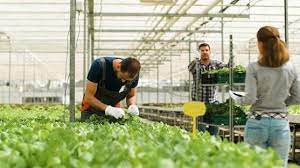I. Introduction
In the face of urbanization and environmental challenges, sustainable agriculture practices have become paramount. Urban farming, a transformative approach to food production within city limits, is at the forefront of this movement. This article explores innovative sustainable agriculture practices in urban farming, showcasing how cities are embracing green initiatives to cultivate a healthier and more environmentally conscious future.
II. Rooftop Farming: Reclaiming Urban Spaces
a. Green Roofs for Agriculture
- Optimizing Space: Rooftop farming utilizes underutilized urban spaces, transforming rooftops into productive agricultural areas.
- Insulation and Energy Efficiency: Green roofs provide insulation, reducing energy consumption for buildings, while simultaneously producing fresh, locally sourced produce.
b. Hydroponics and Vertical Farming
- Soil-Free Cultivation: Hydroponics allows for soil-free farming, utilizing nutrient-rich water solutions and vertical towers to maximize space efficiency.
- Year-Round Production: Vertical farming, often indoors, enables year-round crop cultivation, reducing dependency on seasonal weather conditions.
III. Aquaponics: Symbiotic Ecosystems for Urban Agriculture
a. Harmony of Fish and Plants
- Integrated Systems: Aquaponics combines fish farming with hydroponics, creating a closed-loop system where fish waste fertilizes plants, and plants purify the water for the fish.
- Resource Efficiency: This symbiotic relationship enhances resource efficiency, requiring less water compared to traditional farming methods.
IV. Community Gardens: Fostering Urban Connection
a. Collaborative Green Spaces
- Social Integration: Community gardens promote social cohesion by bringing residents together to cultivate and share in the harvest.
- Educational Opportunities: These spaces offer educational programs, teaching sustainable farming practices and fostering a deeper connection to food sources.
V. Smart Agriculture Technologies
a. IoT Integration for Precision Farming
- Sensor Networks: Internet of Things (IoT) sensors monitor soil moisture, nutrient levels, and environmental conditions, enabling precise and efficient resource management.
- Data-Driven Decision Making: Smart technologies analyze real-time data, allowing urban farmers to make informed decisions, optimize resource usage, and enhance overall productivity.
VI. Agroforestry in Urban Environments
a. Integrating Trees with Agriculture
- Multifunctional Green Spaces: Agroforestry integrates trees into urban farming, providing shade, enhancing biodiversity, and promoting sustainable land use.
- Climate Mitigation: Trees in urban farms contribute to climate mitigation by absorbing carbon dioxide, reducing the urban heat island effect, and supporting overall environmental resilience.
VII. Challenges and Solutions in Urban Farming
a. Land Scarcity and Zoning Issues
- Vertical and Indoor Solutions: Innovative vertical and indoor farming methods address land scarcity by utilizing existing urban structures.
- Policy Advocacy: Advocacy for favorable zoning policies encourages the integration of urban farming into city planning, promoting sustainable land use.
b. Resource Constraints and Efficiency
- Closed-Loop Systems: Closed-loop systems like aquaponics and hydroponics address resource constraints by maximizing efficiency and minimizing water usage.
- Technological Adoption: Embracing smart agriculture technologies enhances resource efficiency through precise monitoring and data-driven decision-making.
VIII. The Future of Urban Farming
a. Green Skyscrapers and Urban Agriculture Hubs
- Skyscrapers as Farms: Futuristic concepts envision skyscrapers designed as vertical farms, acting as self-sustaining food production hubs within urban landscapes.
- Green Roofs Integration: Further integration of green roofs into urban infrastructure becomes a standard, creating a harmonious blend of architecture and agriculture.
IX. Conclusion
Urban farming innovations represent a significant stride towards sustainable agriculture in urban environments. From rooftop gardens to aquaponics systems and smart agriculture technologies, cities are cultivating solutions to address food security, environmental concerns, and community well-being. As urban farming continues to evolve, the integration of green practices into city planning promises a greener, healthier, and more sustainable urban future.
FAQs
- Q: How does aquaponics contribute to resource efficiency in urban farming?
- A: Aquaponics combines fish farming with hydroponics, creating a closed-loop system where fish waste fertilizes plants, and plants purify the water for the fish, enhancing resource efficiency.
- Q: What role do community gardens play in urban farming?
- A: Community gardens foster social integration, providing collaborative green spaces for residents to cultivate and share in the harvest. They also offer educational opportunities to teach sustainable farming practices.
- Q: How can smart agriculture technologies benefit urban farming?
- A: Smart agriculture technologies, including IoT integration, enable precise monitoring of soil conditions and resource usage. Data-driven decision-making enhances overall productivity and resource efficiency in urban farming.
- Q: How do urban farms address land scarcity and zoning issues?
- A: Urban farms address land scarcity by utilizing innovative methods like vertical and indoor farming. Advocacy for favorable zoning policies encourages the integration of urban farming into city planning, promoting sustainable land use.
